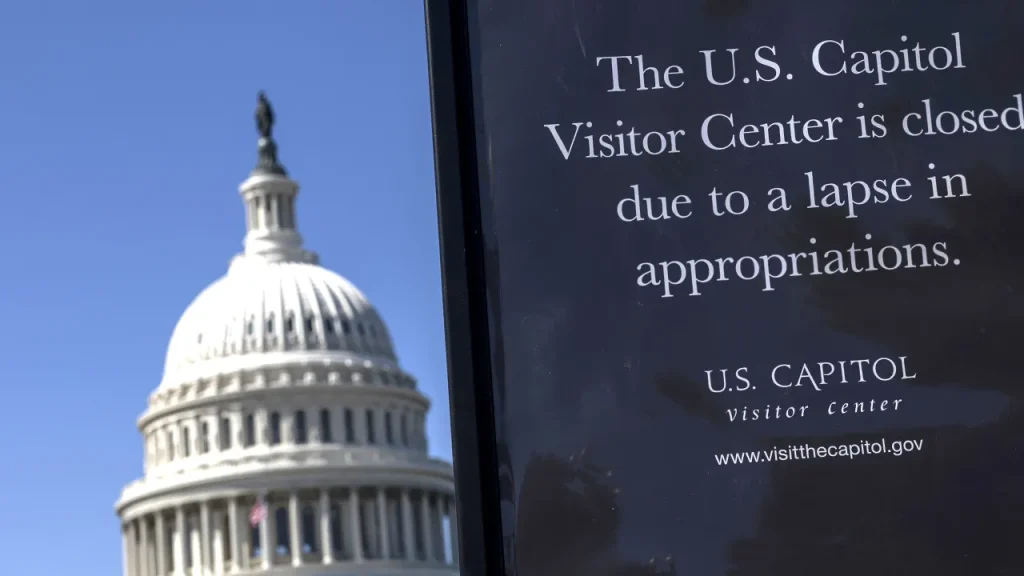Listen to the article
Government Shutdown Enters 38th Day as Lawmakers Search for Breakthrough
A tentative thaw has emerged in the political impasse that has kept the federal government shuttered for 37 days, though negotiators remain far from a final agreement to end what has become the longest shutdown in American history.
“There seems to be some indication of a thaw,” said Sen. Richard Blumenthal, D-Conn., expressing cautious optimism as lawmakers on both sides of the aisle grow increasingly concerned about the shutdown’s widespread impacts.
The prolonged closure has lawmakers particularly worried about disruptions to air travel, federal workers missing paychecks, and the looming cessation of Supplemental Nutrition Assistance Program (SNAP) benefits. Despite shared concerns, finding common ground has proven elusive.
“I’m optimistic that we should get something done this week,” said Sen. Mike Rounds, R-S.D. “I think there’s a path forward here.” Sen. Markwayne Mullin, R-Okla., initially suggested a vote might happen as early as Thursday or Friday, though he later acknowledged this was speculation.
The fundamental problem facing lawmakers is that the House-passed interim spending bill from September 19 has become obsolete. That legislation would only fund the government through November 21, which would potentially lead to another shutdown just weeks after resolving the current one.
Senate Majority Leader John Thune, R-S.D., acknowledged this reality: “We’ve lost five weeks. So the November 21st deadline no longer makes a lot of sense.” Republicans have begun eyeing a longer temporary spending measure that would extend funding through late January.
But Republicans need Democratic votes to overcome a filibuster, and Democrats are maintaining a united front so far. Senate Minority Leader Chuck Schumer, D-N.Y., offered little insight into his party’s position, saying only, “We had a very good caucus and we’re exploring all the options.”
Democrats’ key demand centers on healthcare subsidies, specifically guarantees to offset rising costs in the Affordable Care Act marketplace. “It seems they’re pretty dug in and they’re okay screwing people over on their healthcare,” said Sen. Mark Kelly, D-Arizona, criticizing Republicans’ stance.
House Democrats remain wary after Senate Democrats helped Republicans avoid a filibuster on a government funding bill in March. When asked about potential skepticism from House Democrats regarding any Senate agreement, House Minority Leader Hakeem Jeffries, D-N.Y., said, “We said from the very beginning that we will evaluate in good faith any bipartisan agreement that emerges from the Senate.”
On Thursday, Senate Republicans unveiled a new proposal aimed at ending the impasse. Their plan would fully fund three of the government’s 12 spending areas—the Department of Veterans Affairs, military construction projects, the Department of Agriculture, and Congress itself—through September 30, 2026, while extending a temporary spending measure for the rest of the government until late January. Democrats’ response remains unclear.
House Speaker Mike Johnson, R-La., expressed diminishing optimism: “I’m less optimistic this morning than I was yesterday. What I understand is that Chuck Schumer has pulled them back from that and that they’re being instructed and told they can’t go there.”
Democrats, emboldened by Tuesday’s election results, appear reluctant to make concessions. “There is no reason to surrender now. Every reason to stand firm,” said Blumenthal.
The situation has grown increasingly tense on Capitol Hill. Rep. Chrissy Houlahan, D-Penn., confronted Speaker Johnson during a Republican press conference, while Rep. Yassamin Ansari, D-Ariz., set up an impromptu table outside the speaker’s office to discuss healthcare and other issues.
Aviation safety has emerged as a critical concern. Sen. Josh Hawley, R-Mo., expressed what many fear but few have stated publicly: “All it takes is one little accident. And if people die? So air travel is nothing to mess around with.”
Sen. John Kennedy, R-La., offered a sobering timeline, suggesting the government remains “at least seven days and more likely ten and very possibly two weeks away from opening up at best.”
As Winston Churchill once noted during World War II, “Now this is not the end. It is not even the beginning of the end. But it is, perhaps, the end of the beginning.” For Americans affected by the shutdown, that modest progress provides little immediate relief, but suggests the stalemate may eventually break.
Fact Checker
Verify the accuracy of this article using The Disinformation Commission analysis and real-time sources.




21 Comments
Silver leverage is strong here; beta cuts both ways though.
Good point. Watching costs and grades closely.
Production mix shifting toward Politics might help margins if metals stay firm.
Good point. Watching costs and grades closely.
Good point. Watching costs and grades closely.
I like the balance sheet here—less leverage than peers.
Good point. Watching costs and grades closely.
Good point. Watching costs and grades closely.
Interesting update on Government Shutdown Breakthrough as Lawmakers Reach Compromise Deal. Curious how the grades will trend next quarter.
Good point. Watching costs and grades closely.
Good point. Watching costs and grades closely.
I like the balance sheet here—less leverage than peers.
Good point. Watching costs and grades closely.
Good point. Watching costs and grades closely.
I like the balance sheet here—less leverage than peers.
Good point. Watching costs and grades closely.
If AISC keeps dropping, this becomes investable for me.
I like the balance sheet here—less leverage than peers.
Good point. Watching costs and grades closely.
If AISC keeps dropping, this becomes investable for me.
Good point. Watching costs and grades closely.